KIA Magnetis 2008 2.G Workshop Manual
Manufacturer: KIA, Model Year: 2008, Model line: Magnetis, Model: KIA Magnetis 2008 2.GPages: 289, PDF Size: 4.78 MB
Page 51 of 289
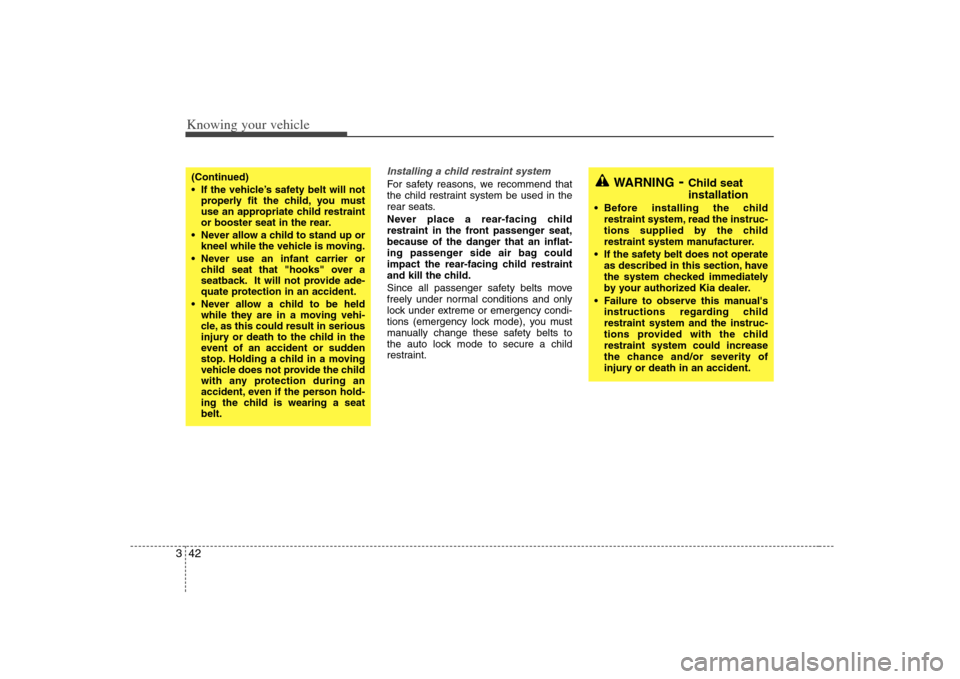
Knowing your vehicle42 3
Installing a child restraint system For safety reasons, we recommend that
the child restraint system be used in the
rear seats.
Never place a rear-facing child
restraint in the front passenger seat,
because of the danger that an inflat-
ing passenger side air bag could
impact the rear-facing child restraint
and kill the child.
Since all passenger safety belts move
freely under normal conditions and only
lock under extreme or emergency condi-
tions (emergency lock mode), you must
manually change these safety belts to
the auto lock mode to secure a child
restraint.
(Continued)
If the vehicle’s safety belt will not
properly fit the child, you must
use an appropriate child restraint
or booster seat in the rear.
Never allow a child to stand up or
kneel while the vehicle is moving.
Never use an infant carrier or
child seat that "hooks" over a
seatback. It will not provide ade-
quate protection in an accident.
Never allow a child to be held
while they are in a moving vehi-
cle, as this could result in serious
injury or death to the child in the
event of an accident or sudden
stop. Holding a child in a moving
vehicle does not provide the child
with any protection during an
accident, even if the person hold-
ing the child is wearing a seat
belt.
WARNING
- Child seat
installation
Before installing the child
restraint system, read the instruc-
tions supplied by the child
restraint system manufacturer.
If the safety belt does not operate
as described in this section, have
the system checked immediately
by your authorized Kia dealer.
Failure to observe this manual's
instructions regarding child
restraint system and the instruc-
tions provided with the child
restraint system could increase
the chance and/or severity of
injury or death in an accident.
Page 52 of 289
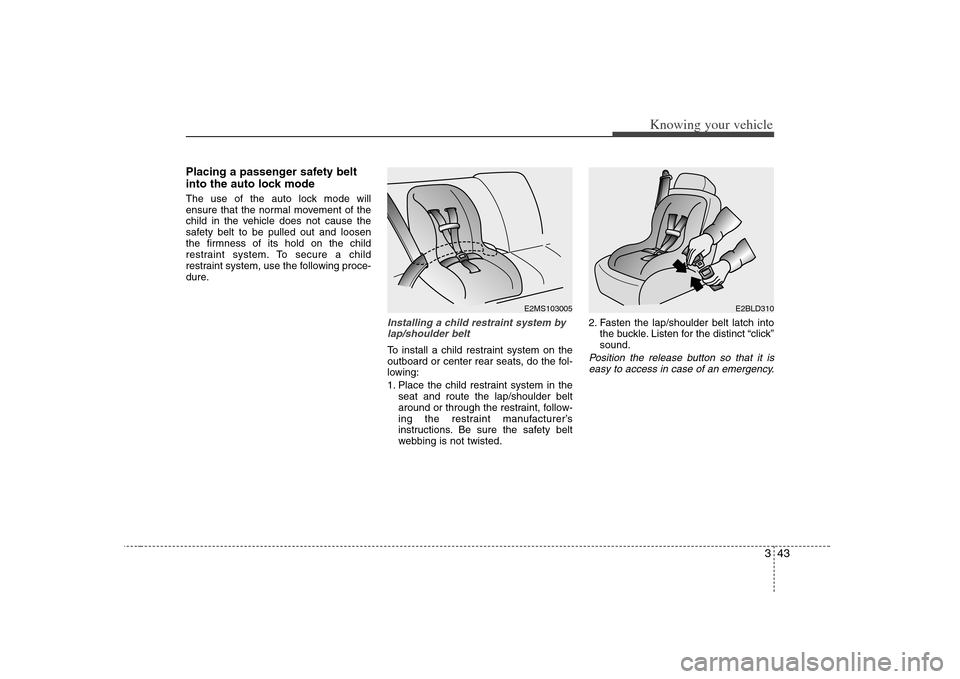
343
Knowing your vehicle
Placing a passenger safety belt
into the auto lock modeThe use of the auto lock mode will
ensure that the normal movement of the
child in the vehicle does not cause the
safety belt to be pulled out and loosen
the firmness of its hold on the child
restraint system. To secure a child
restraint system, use the following proce-
dure.
Installing a child restraint system by
lap/shoulder beltTo install a child restraint system on the
outboard or center rear seats, do the fol-
lowing:
1. Place the child restraint system in the
seat and route the lap/shoulder belt
around or through the restraint, follow-
ing the restraint manufacturer’s
instructions. Be sure the safety belt
webbing is not twisted.2. Fasten the lap/shoulder belt latch into
the buckle. Listen for the distinct “click”
sound.
Position the release button so that it is
easy to access in case of an emergency.
E2MS103005
E2BLD310
Page 53 of 289
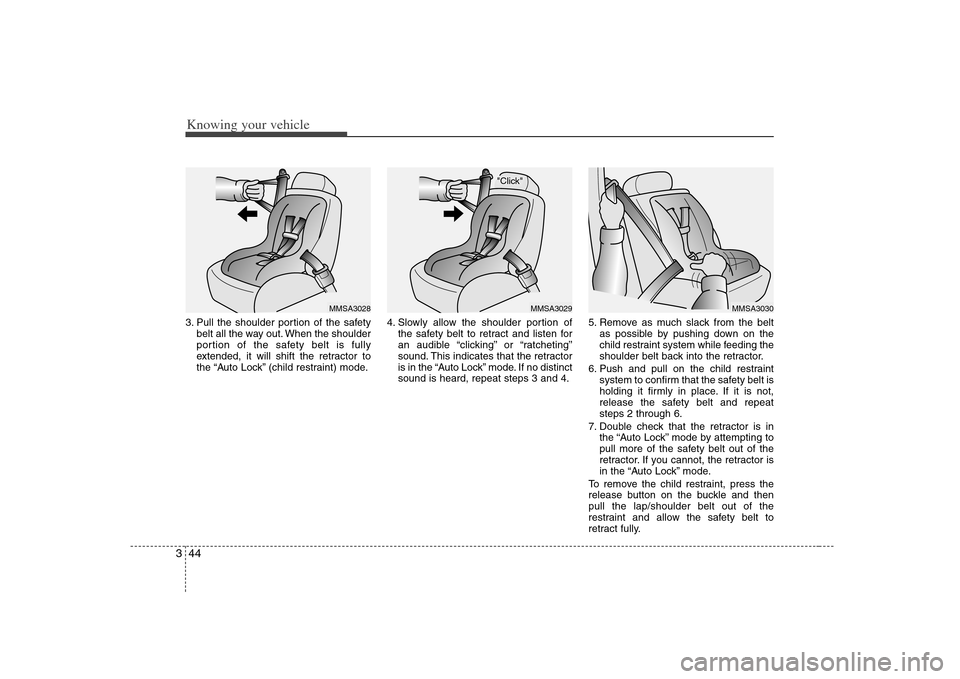
Knowing your vehicle44 33. Pull the shoulder portion of the safety
belt all the way out. When the shoulder
portion of the safety belt is fully
extended, it will shift the retractor to
the “Auto Lock” (child restraint) mode.4. Slowly allow the shoulder portion of
the safety belt to retract and listen for
an audible “clicking” or “ratcheting”
sound. This indicates that the retractor
is in the “Auto Lock” mode. If no distinct
sound is heard, repeat steps 3 and 4.5. Remove as much slack from the belt
as possible by pushing down on the
child restraint system while feeding the
shoulder belt back into the retractor.
6. Push and pull on the child restraint
system to confirm that the safety belt is
holding it firmly in place. If it is not,
release the safety belt and repeat
steps 2 through 6.
7. Double check that the retractor is in
the “Auto Lock” mode by attempting to
pull more of the safety belt out of the
retractor. If you cannot, the retractor is
in the “Auto Lock” mode.
To remove the child restraint, press the
release button on the buckle and then
pull the lap/shoulder belt out of the
restraint and allow the safety belt to
retract fully.
"Click"
MMSA3029
MMSA3028
MMSA3030
Page 54 of 289
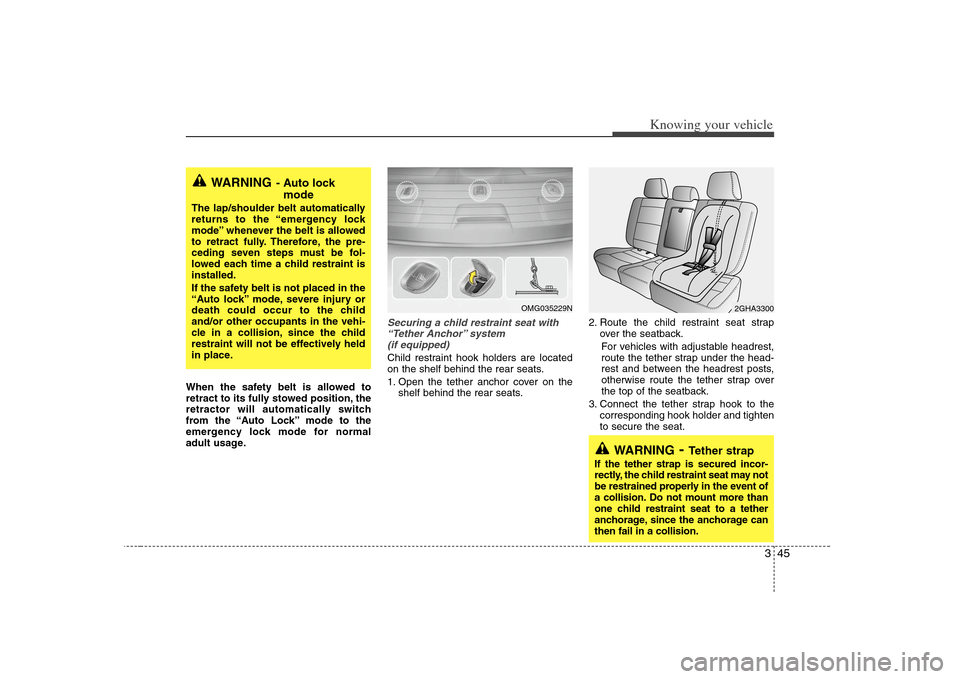
345
Knowing your vehicle
When the safety belt is allowed to
retract to its fully stowed position, the
retractor will automatically switch
from the “Auto Lock” mode to the
emergency lock mode for normal
adult usage.
Securing a child restraint seat with
“Tether Anchor” system
(if equipped) Child restraint hook holders are located
on the shelf behind the rear seats.
1. Open the tether anchor cover on the
shelf behind the rear seats.2. Route the child restraint seat strap
over the seatback.
For vehicles with adjustable headrest,
route the tether strap under the head-
rest and between the headrest posts,
otherwise route the tether strap over
the top of the seatback.
3. Connect the tether strap hook to the
corresponding hook holder and tighten
to secure the seat.
WARNING
- Auto lock
mode
The lap/shoulder belt automatically
returns to the “emergency lock
mode” whenever the belt is allowed
to retract fully. Therefore, the pre-
ceding seven steps must be fol-
lowed each time a child restraint is
installed.
If the safety belt is not placed in the
“Auto lock” mode, severe injury or
death could occur to the child
and/or other occupants in the vehi-
cle in a collision, since the child
restraint will not be effectively held
in place.
2GHA3300
WARNING
- Tether strap
If the tether strap is secured incor-
rectly, the child restraint seat may not
be restrained properly in the event of
a collision. Do not mount more than
one child restraint seat to a tether
anchorage, since the anchorage can
then fail in a collision.
OMG035229N
Page 55 of 289
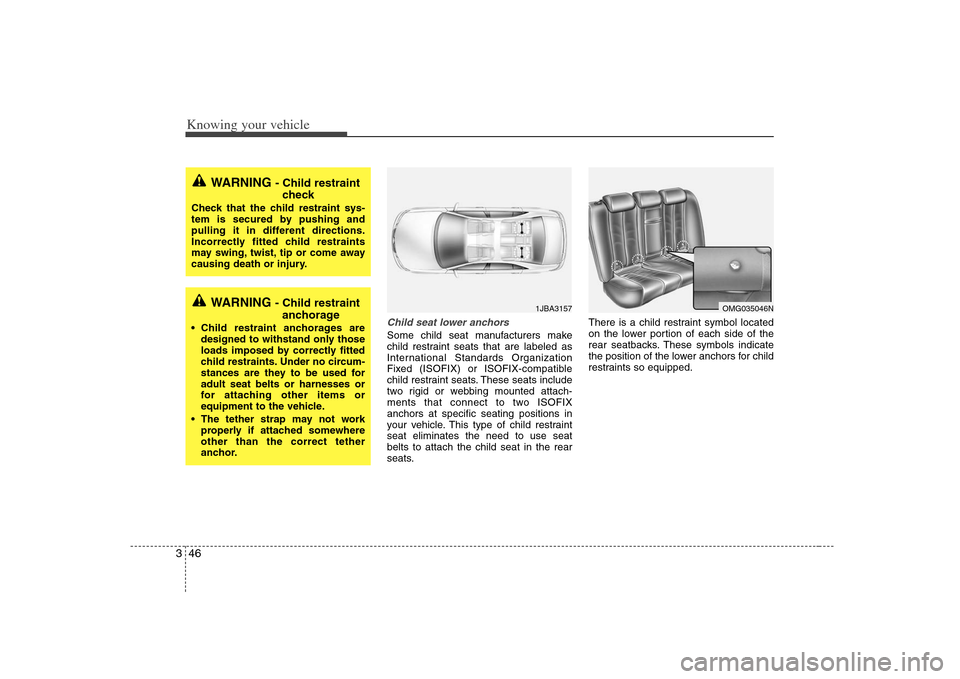
Knowing your vehicle46 3
Child seat lower anchorsSome child seat manufacturers make
child restraint seats that are labeled as
International Standards Organization
Fixed (ISOFIX) or ISOFIX-compatible
child restraint seats. These seats include
two rigid or webbing mounted attach-
ments that connect to two ISOFIX
anchors at specific seating positions in
your vehicle. This type of child restraint
seat eliminates the need to use seat
belts to attach the child seat in the rear
seats.There is a child restraint symbol located
on the lower portion of each side of the
rear seatbacks. These symbols indicate
the position of the lower anchors for child
restraints so equipped.
WARNING
- Child restraint
check
Check that the child restraint sys-
tem is secured by pushing and
pulling it in different directions.
Incorrectly fitted child restraints
may swing, twist, tip or come away
causing death or injury.
WARNING
- Child restraint
anchorage
Child restraint anchorages are
designed to withstand only those
loads imposed by correctly fitted
child restraints. Under no circum-
stances are they to be used for
adult seat belts or harnesses or
for attaching other items or
equipment to the vehicle.
The tether strap may not work
properly if attached somewhere
other than the correct tether
anchor.
1JBA3157
OMG035046N
Page 56 of 289
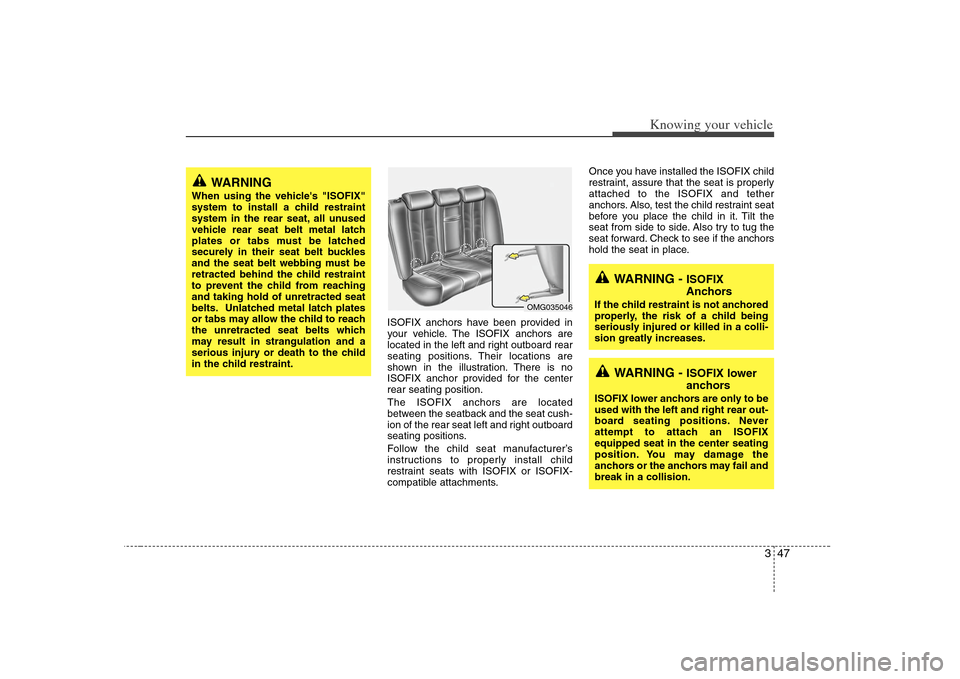
347
Knowing your vehicle
ISOFIX anchors have been provided in
your vehicle. The ISOFIX anchors are
located in the left and right outboard rear
seating positions. Their locations are
shown in the illustration. There is no
ISOFIX anchor provided for the center
rear seating position.
The ISOFIX anchors are located
between the seatback and the seat cush-
ion of the rear seat left and right outboard
seating positions.
Follow the child seat manufacturer’s
instructions to properly install child
restraint seats with ISOFIX or ISOFIX-
compatible attachments.Once you have installed the ISOFIX child
restraint, assure that the seat is properly
attached to the ISOFIX and tether
anchors. Also, test the child restraint seat
before you place the child in it. Tilt the
seat from side to side. Also try to tug the
seat forward. Check to see if the anchors
hold the seat in place.
WARNING -
ISOFIX
Anchors
If the child restraint is not anchored
properly, the risk of a child being
seriously injured or killed in a colli-
sion greatly increases.
WARNING -
ISOFIX lower
anchors
ISOFIX lower anchors are only to be
used with the left and right rear out-
board seating positions. Never
attempt to attach an ISOFIX
equipped seat in the center seating
position. You may damage the
anchors or the anchors may fail and
break in a collision.
WARNING
When using the vehicle's "ISOFIX"
system to install a child restraint
system in the rear seat, all unused
vehicle rear seat belt metal latch
plates or tabs must be latched
securely in their seat belt buckles
and the seat belt webbing must be
retracted behind the child restraint
to prevent the child from reaching
and taking hold of unretracted seat
belts. Unlatched metal latch plates
or tabs may allow the child to reach
the unretracted seat belts which
may result in strangulation and a
serious injury or death to the child
in the child restraint.
OMG035046
Page 57 of 289
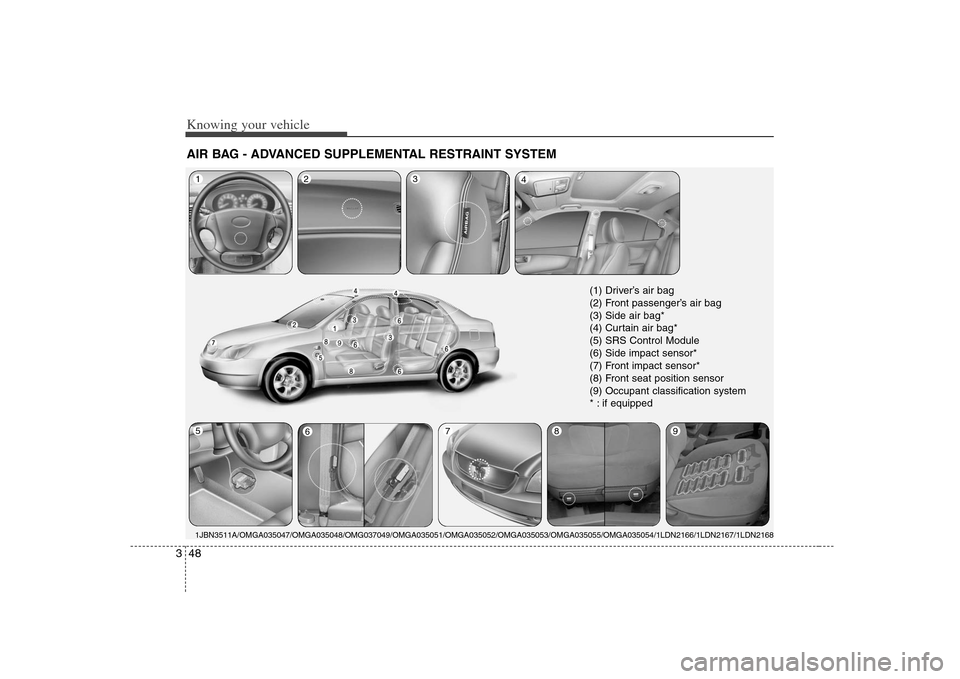
Knowing your vehicle48 3AIR BAG - ADVANCED SUPPLEMENTAL RESTRAINT SYSTEM 1JBN3511A/OMGA035047/OMGA035048/OMG037049/OMGA035051/OMGA035052/OMGA035053/OMGA035055/OMGA035054/1LDN2166/1LDN2167/1LDN21681
2
3
5
4
7
(1) Driver’s air bag
(2) Front passenger’s air bag
(3) Side air bag*
(4) Curtain air bag*
(5) SRS Control Module
(6) Side impact sensor*
(7) Front impact sensor*
(8) Front seat position sensor
(9) Occupant classification system
* : if equipped
9
8
6
Page 58 of 289
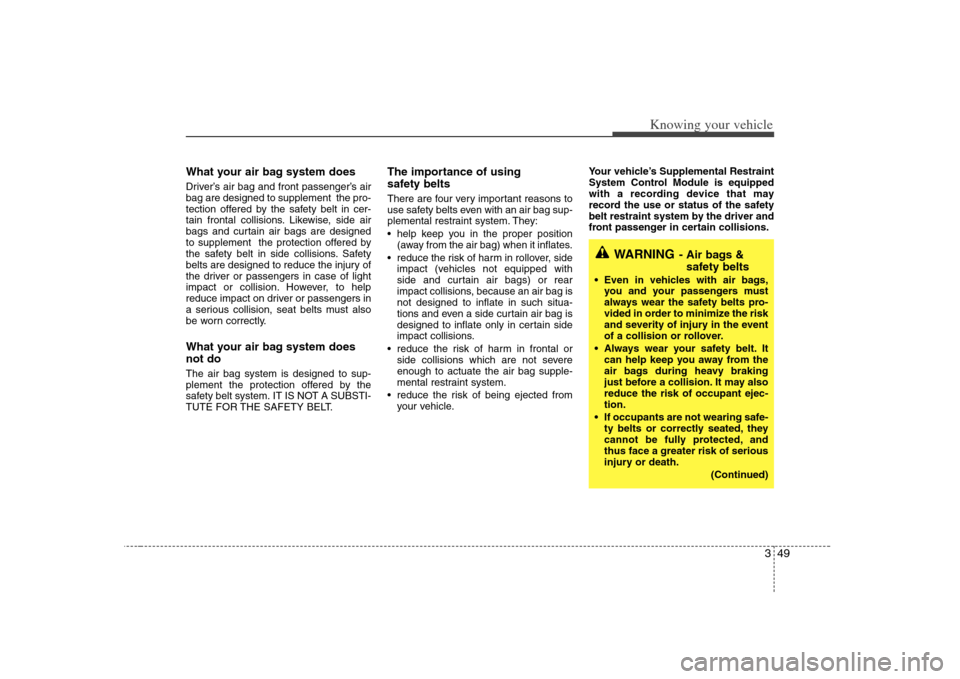
349
Knowing your vehicle
What your air bag system doesDriver’s air bag and front passenger’s air
bag are designed to supplement the pro-
tection offered by the safety belt in cer-
tain frontal collisions. Likewise, side air
bags and curtain air bags are designed
to supplement the protection offered by
the safety belt in side collisions. Safety
belts are designed to reduce the injury of
the driver or passengers in case of light
impact or collision. However, to help
reduce impact on driver or passengers in
a serious collision, seat belts must also
be worn correctly.What your air bag system does
not doThe air bag system is designed to sup-
plement the protection offered by the
safety belt system. IT IS NOT A SUBSTI-
TUTE FOR THE SAFETY BELT.
The importance of using
safety beltsThere are four very important reasons to
use safety belts even with an air bag sup-
plemental restraint system. They:
help keep you in the proper position
(away from the air bag) when it inflates.
reduce the risk of harm in rollover, side
impact (vehicles not equipped with
side and curtain air bags) or rear
impact collisions, because an air bag is
not designed to inflate in such situa-
tions and even a side curtain air bag is
designed to inflate only in certain side
impact collisions.
reduce the risk of harm in frontal or
side collisions which are not severe
enough to actuate the air bag supple-
mental restraint system.
reduce the risk of being ejected from
your vehicle.Your vehicle’s Supplemental Restraint
System Control Module is equipped
with a recording device that may
record the use or status of the safety
belt restraint system by the driver and
front passenger in certain collisions.
WARNING
- Air bags &
safety belts
Even in vehicles with air bags,
you and your passengers must
always wear the safety belts pro-
vided in order to minimize the risk
and severity of injury in the event
of a collision or rollover.
Always wear your safety belt. It
can help keep you away from the
air bags during heavy braking
just before a collision. It may also
reduce the risk of occupant ejec-
tion.
If occupants are not wearing safe-
ty belts or correctly seated, they
cannot be fully protected, and
thus face a greater risk of serious
injury or death.
(Continued)
Page 59 of 289
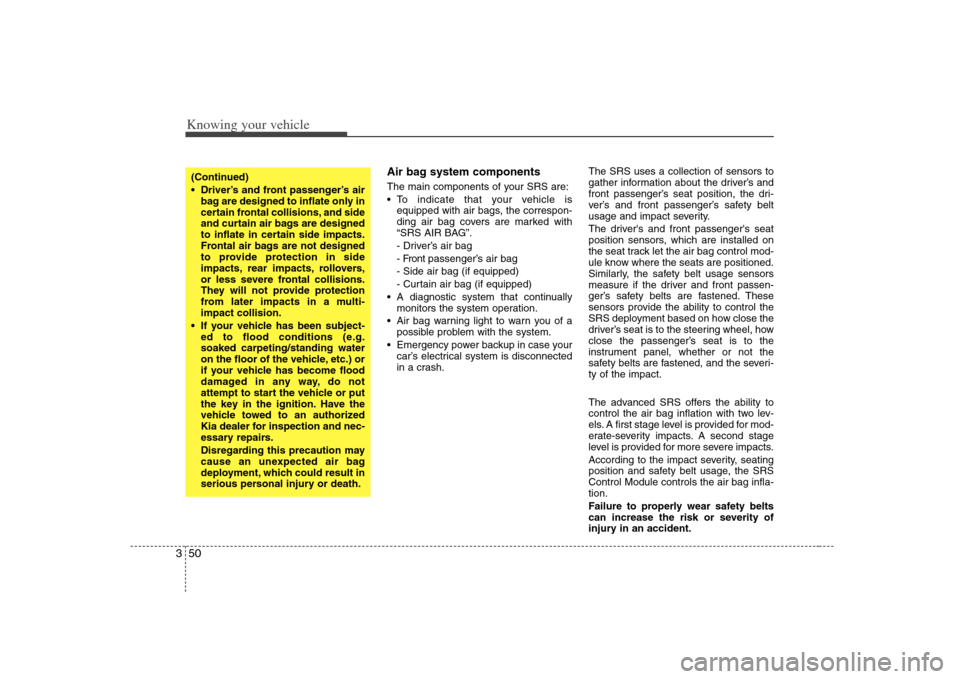
Knowing your vehicle50 3
Air bag system components The main components of your SRS are:
To indicate that your vehicle is
equipped with air bags, the correspon-
ding air bag covers are marked with
“SRS AIR BAG”.
- Driver’s air bag
- Front passenger’s air bag
- Side air bag (if equipped)
- Curtain air bag (if equipped)
A diagnostic system that continually
monitors the system operation.
Air bag warning light to warn you of a
possible problem with the system.
Emergency power backup in case your
car’s electrical system is disconnected
in a crash.The SRS uses a collection of sensors to
gather information about the driver’s and
front passenger’s seat position, the dri-
ver’s and front passenger’s safety belt
usage and impact severity.
The driver's and front passenger's seat
position sensors, which are installed on
the seat track let the air bag control mod-
ule know where the seats are positioned.
Similarly, the safety belt usage sensors
measure if the driver and front passen-
ger’s safety belts are fastened. These
sensors provide the ability to control the
SRS deployment based on how close the
driver’s seat is to the steering wheel, how
close the passenger’s seat is to the
instrument panel, whether or not the
safety belts are fastened, and the severi-
ty of the impact.
The advanced SRS offers the ability to
control the air bag inflation with two lev-
els. A first stage level is provided for mod-
erate-severity impacts. A second stage
level is provided for more severe impacts.
According to the impact severity, seating
position and safety belt usage, the SRS
Control Module controls the air bag infla-
tion.
Failure to properly wear safety belts
can increase the risk or severity of
injury in an accident.
(Continued)
Driver’s and front passenger’s air
bag are designed to inflate only in
certain frontal collisions, and side
and curtain air bags are designed
to inflate in certain side impacts.
Frontal air bags are not designed
to provide protection in side
impacts, rear impacts, rollovers,
or less severe frontal collisions.
They will not provide protection
from later impacts in a multi-
impact collision.
If your vehicle has been subject-
ed to flood conditions (e.g.
soaked carpeting/standing water
on the floor of the vehicle, etc.) or
if your vehicle has become flood
damaged in any way, do not
attempt to start the vehicle or put
the key in the ignition. Have the
vehicle towed to an authorized
Kia dealer for inspection and nec-
essary repairs.
Disregarding this precaution may
cause an unexpected air bag
deployment, which could result in
serious personal injury or death.
Page 60 of 289
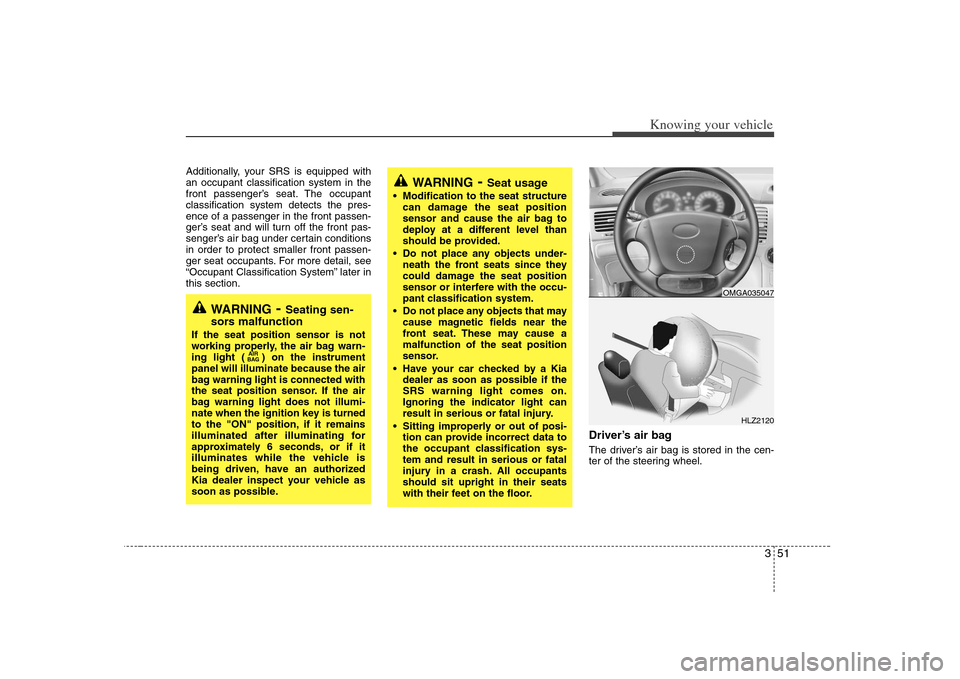
351
Knowing your vehicle
Additionally, your SRS is equipped with
an occupant classification system in the
front passenger’s seat. The occupant
classification system detects the pres-
ence of a passenger in the front passen-
ger’s seat and will turn off the front pas-
senger’s air bag under certain conditions
in order to protect smaller front passen-
ger seat occupants. For more detail, see
“Occupant Classification System” later in
this section.
Driver’s air bag The driver’s air bag is stored in the cen-
ter of the steering wheel.
WARNING
- Seating sen-
sors malfunction
If the seat position sensor is not
working properly, the air bag warn-
ing light ( ) on the instrument
panel will illuminate because the air
bag warning light is connected with
the seat position sensor. If the air
bag warning light does not illumi-
nate when the ignition key is turned
to the "ON" position, if it remains
illuminated after illuminating for
approximately 6 seconds, or if it
illuminates while the vehicle is
being driven, have an authorized
Kia dealer inspect your vehicle as
soon as possible.
AIR
BAG
WARNING
- Seat usage
Modification to the seat structure
can damage the seat position
sensor and cause the air bag to
deploy at a different level than
should be provided.
Do not place any objects under-
neath the front seats since they
could damage the seat position
sensor or interfere with the occu-
pant classification system.
Do not place any objects that may
cause magnetic fields near the
front seat. These may cause a
malfunction of the seat position
sensor.
Have your car checked by a Kia
dealer as soon as possible if the
SRS warning light comes on.
Ignoring the indicator light can
result in serious or fatal injury.
Sitting improperly or out of posi-
tion can provide incorrect data to
the occupant classification sys-
tem and result in serious or fatal
injury in a crash. All occupants
should sit upright in their seats
with their feet on the floor.
HLZ2120
OMGA035047